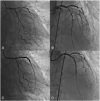Successful emergent transcatheter aortic valve implantation and left ventricular unloading by Impella in a patient with severe aortic stenosis who experienced cardiogenic shock after primary percutaneous coronary intervention for ST-elevation myocardial infarction: a case report
- PMID: 33629024
- PMCID: PMC7889717
- DOI: 10.1093/ehjcr/ytab033
Successful emergent transcatheter aortic valve implantation and left ventricular unloading by Impella in a patient with severe aortic stenosis who experienced cardiogenic shock after primary percutaneous coronary intervention for ST-elevation myocardial infarction: a case report
Abstract
Background: Determining the treatment strategy for cardiogenic shock following ST-elevation myocardial infarction in a patient with severe aortic stenosis remains challenging and is a matter of debate.
Case summary: An 84-year-old man with chest pain was transferred to our institute and subsequently diagnosed with ST-elevation myocardial infarction and Killip class III heart failure. The patient was intubated, and urgent coronary angiography revealed severe tandem stenosis from the proximal to mid-left anterior descending coronary artery. We performed a primary percutaneous coronary intervention (PCI) and deployed drug-eluting stents from the left main trunk to mid-left anterior descending coronary artery. Although the procedure was successful, the patient went into cardiogenic shock a few hours later. Transthoracic echocardiography revealed low cardiac function and severe aortic stenosis. We decided to perform transcatheter aortic valve implantation using a self-expandable valve, followed by the insertion of a left ventricular assist device. The combination of procedures achieved haemodynamic stability.
Discussion: It is difficult to treat cardiogenic shock that develops in patients with severe aortic stenosis and ST-elevation myocardial infarction. This case report demonstrates that combined transcatheter aortic valve replacement using a self-expanding valve and left ventricular assist device placement can be safe and effective after a primary PCI.
Keywords: Aortic stenosis; Cardiogenic shock; Case report; Impella CP; ST-elevation myocardial infarction; Transcatheter aortic valve implantation.
© The Author(s) 2021. Published by Oxford University Press on behalf of the European Society of Cardiology.
Figures




Similar articles
-
Case Report: Balloon aortic valvuloplasty with subsequent Impella support as bridge therapy to transcatheter aortic valve replacement in cardiogenic shock with severe aortic stenosis.Front Cardiovasc Med. 2025 May 22;12:1583801. doi: 10.3389/fcvm.2025.1583801. eCollection 2025. Front Cardiovasc Med. 2025. PMID: 40476142 Free PMC article.
-
Bail-Out Use of Impella CP as a Bridge to TAVI in a Cardiogenic Shock Patient: The "Pump-Rewiring" Technique.J Invasive Cardiol. 2016 Jan;28(1):E1-5. J Invasive Cardiol. 2016. PMID: 26716594
-
Rotational atherectomy of left main stem immediately after transcatheter aortic valve implantation in a patient with symptomatic severe aortic stenosis and an impaired left ventricular systolic function: a case report.Eur Heart J Case Rep. 2023 Jul 8;7(7):ytad301. doi: 10.1093/ehjcr/ytad301. eCollection 2023 Jul. Eur Heart J Case Rep. 2023. PMID: 37470061 Free PMC article.
-
Use of Impella 5.0 Prior to Transcatheter Aortic Valve Replacement in a Patient with Severe Aortic Stenosis and Cardiogenic Shock.J Heart Valve Dis. 2017 Jul;26(4):485-487. J Heart Valve Dis. 2017. PMID: 29302950 Review.
-
The use of percutaneous left ventricular assist device in high-risk percutaneous coronary intervention and cardiogenic shock.Rev Cardiovasc Med. 2013;14(2-4):e144-9. doi: 10.3909/ricm0675. Rev Cardiovasc Med. 2013. PMID: 24448256 Review.
Cited by
-
Concomitant percutaneous coronary intervention and transcatheter aortic valve replacement for aortic stenosis complicated with acute STEMI: a case report and literature review.Front Cardiovasc Med. 2023 Nov 28;10:1291089. doi: 10.3389/fcvm.2023.1291089. eCollection 2023. Front Cardiovasc Med. 2023. PMID: 38089776 Free PMC article.
-
Report of Accidental Anchoring of an Impella Device to a Perceval Bioprosthesis in a Patient.JACC Case Rep. 2022 Nov 16;4(23):101674. doi: 10.1016/j.jaccas.2022.09.032. eCollection 2022 Dec 7. JACC Case Rep. 2022. PMID: 36438430 Free PMC article.
References
-
- Maini B, Gregory D, Scotti DJ, Buyantseva L. Percutaneous cardiac assist devices compared with surgical hemodynamic support alternatives: cost-effectiveness in the emergent setting. Catheter Cardiovasc Interv 2014;83:E183–E192. - PubMed
-
- Selle A, Figulla HR, Ferrari M, Rademacher W, Goebel B, Hamadanchi A. et al. Impact of rapid ventricular pacing during TAVI on microvascular tissue perfusion. Clin Res Cardiol 2014;103:902–911. - PubMed
-
- Moriki T, Tobaru T, Higuchi R, Shimizu J, Takanashi S, Takayama M. The brand-new Inoue balloon for retrograde approach: first experience in Japan. Cardiovasc Interv and Ther 2019;34:293–294. - PubMed
-
- Thiele H, Zeymer U, Neumann FJ, Ferenc M, Olbrich HG, Hausleiter J. et al. Intraaortic balloon support for myocardial infarction with cardiogenic shock. N Engl J Med 2012;367:1287–1296. - PubMed
-
- Papaioannou TG, Terrovitis J, Kanakakis J, Stamatelopoulos KS, Protogerou AD, Lekakis JP. et al. Heart rate effect on hemodynamics during mechanical assistance by intra-aortic balloon pump. Int J Artif Organs 2002;25:1160–1165. - PubMed
Publication types
LinkOut - more resources
Full Text Sources
Other Literature Sources
Miscellaneous
